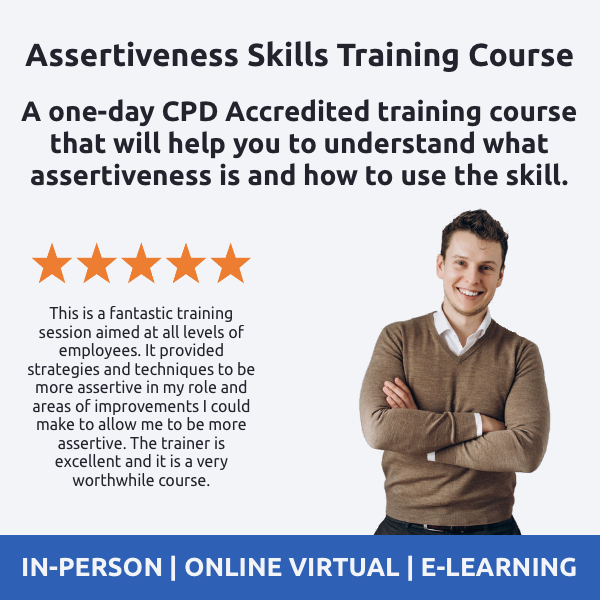Background
In this article, we look at how to say no with confidence. No is a word that many people find difficult to say. This leads to increased workloads and in some cases being taken advantage of.
It isn’t always the case that people can’t say no. They do, but the no gets over-turned and this leads to a lack of confidence to say no. By understanding how to say no with confidence, we can greatly reduce our workload and stress levels.
Why Should We Say No?
A term in time management suggests that when we want something done we take the path of least resistance. This means we take the easiest route possible. When this requires help and support from others, we choose people that offer little resistance. These tend to be people who say yes!
If we don’t say no we:
- End up with too many tasks to complete
- Our stress levels increase
- Our wellbeing can suffer
- The quality of our own work deteriorates
- People take advantage of us
- We work longer hours
We need to be able to say no to ensure we have control over our workload and that we don’t become overwhelmed with tasks. When we have too much on, even the best time management tools can’t always help us. As things become delayed, the people expecting work begin to add more pressure and we eventually burn out.
If we become known as the person who always says yes, others can take advantage of this and will always come to us first, knowing there is likely to be little resistance. And, because we have said yes in the past, we now find it increasingly difficult to say no in the future.
We need to be able to say no when we have to but, to make it work and stick, we need to be able to say no with confidence.
How to Say No With Confidence
Now that we understand the reasons why we should say no, we need to know how to say no with confidence. Saying no with confidence means that when we say no, it sticks. The person that we say no to understands that we are not going to do what they have asked. But, we need to do this in such a way that we don’t damage the relationship that exists between you and them.
We also don’t want to be seen as the person that always says no. This can be very negative too. When we say no, we need to ensure that it is done positively but confidently.
To help us to say no with confidence, we need different ways of saying no. We can use these different ways for different situations. If we mix up the way that we say no, it is less likely that we are seen as the person who always says no. That’s because it doesn’t sound the same each and every time.
Different Ways to Say No
There are lots of different ways to say no and this depends on the situation and what you are saying no to. Understanding these different way increases our ability to say no with confidence. The different ways to say no are:
- The straight no
- The soft no
- The positive no
- Saying no without using the word no
The Straight No
The straight no is not as direct as it sounds. It does give the impression that we should just say no and that’s it. This doesn’t have the impact that we want to have as by doing so, we are likely to damage the relationship. In fact, the straight no is far more positive. It comes in three parts:
- Reasons – we provide the reasons why we have to say no first. Although we use the words reasons to suggest multiple reasons, it’s better to just pick one reason – the most compelling reason. This shows that we have thought about the response and are not simply dismissing their request. We help them to see there is some rationale behind our response and this makes it easier for them to accept. Care needs to be taken that this is delivered confidently as this may just be seen as justification.
- Empathy – we show that we understand their position. This shows we are taking it seriously. It also shows that this is a refusal and not a rejection. We could say something like “I understand that this task is important to you” or “I can see that you really need this done”.
- Alternatives – we offer an alternative to their request. This shows we care about their interests and want to help but we can’t meet their need just now because of the reasons we gave at stage 1. This provides a positive outcome to the conversation.
The Soft No
The soft no is a method where we show that we can’t do what is being asked rather than actually saying the word no. While this works, it can be perceived that we are not saying no with confidence or conviction. There are 4 parts or 4 ways to use the soft no:
- Analogy – Use an example, analogy or evidence to illustrate why you can’t say yes. For example, you might show them your current to-do list or schedule that shows you are already really busy.
- Suggest an alternative – Point out a way of solving the problem that doesn’t involve you. For example, suggest someone else that has the skills to carry out the task
- Facilitate – Rather than say no yourself, get them to say no for you? This might involve the use of both of the above to the point where they say that you are too busy and that they should find someone else or another way
- Put your refusal in context – Talk about how doing their task will impact your other work and the consequences of this.
The Positive No
In the book, The Power of a Positive No: How to Say No and Still Get to Yes by William Ury, the author describes the positive no. This is another great way of being able to say no with confidence.
The positive no uses a YES – NO – YES response.
This ‘Positive No’ has three parts:
- Yes. It begins by saying yes to yourself and protecting what is important to you
- No. It then moves on with a matter-of-fact No that sets clear boundaries
- Yes. A positive no ends with a yes that affirms the relationship and offers another solution to the person’s request.
So, for example:
“Thank you for considering me to do this task for you” – the yes
“Unfortunately, I can’t do this for you as I have other tasks that have pressing deadlines and can’t be moved” – the no.
“You could try asking Annie to do this for you, or I can offer you some help later in the week when I have less to do.”
Saying No Without Using the Word No
Normally when we say no, we say no, justify our reasons and then hopefully offer an alternative. We think this works because the justification and alternative provide a reason and a positive outcome. The thing is, what can happen is the person to who we say this actually only hears one word – no!
For example “no, because I have to get this report done for a client by the end of today. But, what I can do is help you tomorrow afternoon when I have some more time.”
A great way to say no with confidence is to not use the word no at all. What we can do is lead with the benefit and then the justification. There is no need for the word no. For example “what I can do is help tomorrow afternoon as today I have to finish this report that has to go to a client.”
We take out the no and make the statement sound much more positive and is a great way to say no with confidence.
Further Learning
If you would like to learn more about how to say no with confidence, take a look at our Assertiveness Training Course where this subject is covered in much more depth.





